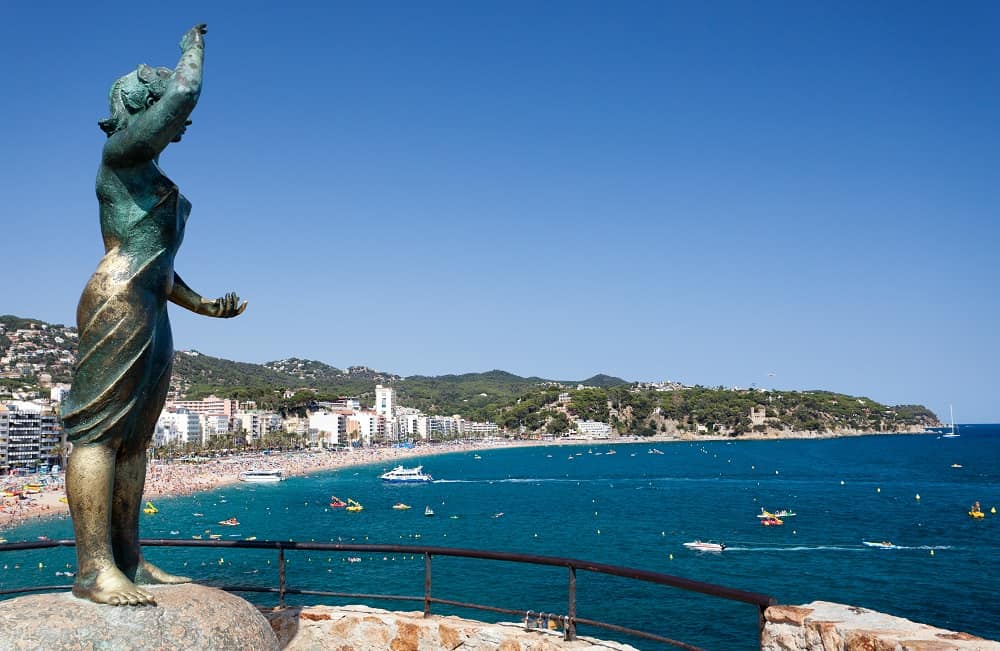
Lloret de Mar has of course been known for years the largest nightlife paradise in Europe. Every year, hundreds of thousands of tourists visit this beautiful seaside resort for the ultimate sun, sea, beach and party holiday. Because in addition to nightlife, Lloret de Mar is, thanks to its beautiful location on the Costa Brava and wonderful Mediterranean climate, with its 8 beautiful beaches also a true paradise for sun and beach worshipers.
What many people don't know is that Lloret de Mar also has more than enough to offer in terms of culture and history. In this article I will therefore take you through the history and 23 sights in Lloret de Mar..
The Beautiful Medieval History of Lloret de Mar
Before tourists the beauty of the beaches and picturesque bays of Lloret de Mar discovered, Lloret de Mar was a small fishing village mainly driven by sea trade. In 1778, King Charles III of Spain issued the decree of free trade with the American colonies from. During this period, large ships were built on the beaches of Lloret destined for America. Many residents subsequently decided to go to America in search of the big fortune. Today, this group is commemorated by the inhabitants of Lloret de Mar as the 'Indianos' or 'Americanos'.
However, Lloret de Mar's history dates back much further than the 18th century. For example, settlements have been found from the 3rd and 4th centuries BC and Lloret was first found in the historical records in 966 as “Loredo”. However, in 1001 Lloret Mar became part of what is now Girona. At this time, Lloret de Mar mainly consisted of farmhouses in the interior, an old Romanesque church of Sant Romà and the tower of Sant Joan.
Thanks to the protection provided by the tower against attacks from the sea, an increasing proportion of the population moved after the coast. The overseas sales of goods, fishing and trade along the coast of the Costa Brava,, gradually became more important.
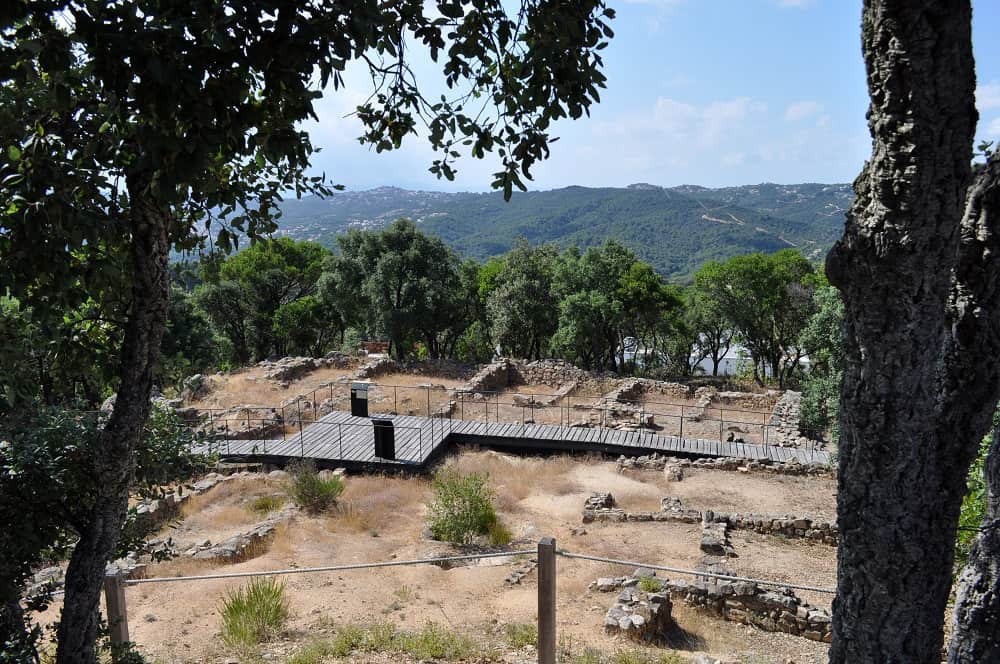
The history of Lloret de Mar thus, as far as is known, dates back to the 3th á 4th century BC. Today, in Lloret de Mar, there are still historical sights and traditions to be seen from these appealing periods in our history.
Do you want to know everything about the beautiful and historical part of Lloret de Mar? Then read on to get acquainted with the 23 beautiful sights in Lloret de Mar.
1. The 2 Beautiful Castles of Lloret de Mar
1.1. Castell de Sant Joan
Castell de Sant Joan is located on a high cliff between it Lloret de Mar main beach and Fenals beach, and is one of the oldest buildings in Lloret de Mar. The castle was built in the mid-13sth century, but its famous tower, protecting the city from sea attacks, was already built in the early 11'sth century. The beautiful castle, which at that time consisted of large battlements, a high tower and chapel, had suffered tremendously over the centuries under various attacks from the sea. The final blow, however, was a bombing in the early 19th century during the Third Coalition War by British guns.
From 1960 to 1992, several restorations were carried out to restore the castle's former glory to some extent. Today, however, only a few vestiges of the original fort can be seen from the 11th can be viewed for a century. The parade piece is the Tower of Tribute (Homenaje in Spanish). Hike uphill to the top of the hill and you will be rewarded, at a height of 60 meters, with a breathtaking, panoramic view of the sea and the Mediterranean coastline.
Opening hours:
October to May: open on Saturday, Sunday and public holidays from 10am to 2pm
June to September: open Monday to Sunday from 10am to 1pm and 5pm to 7pm
Note: closed on December 25 and 26 and January 1 and 6
Entrance fee:
The entrance fee to Castell de Sant Joan is € 3 for adults. For pensioners, minors, large families and disabled people, a reduced price of € 1.50 applies.
1.2. Castell d'en Plaja
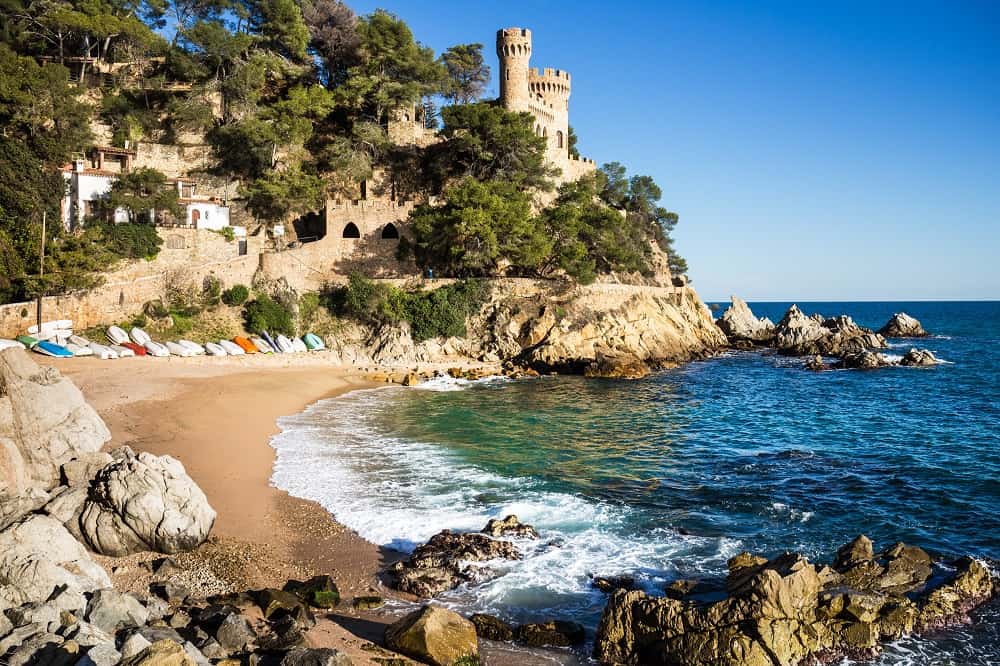
Right next to Playa de Lloret, at the north end, you will find the picturesque bay of Sa Caleta. At the foot of the hill at Sa Caleta you will find the majestic looking Castell d'en Plaja. Although this breathtaking castle in Lloret de Mar looks like it carries a medieval history, its construction did not start until 1935. This beautiful castle in Lloret de Mar is privately owned, unfortunately it is not accessible to tourists. You can, however a visit to the picturesque beach of Sa Caleta combine with a beautiful walk around the castle.
Castell d'en Plaja is therefore not a highlight in the historical field, but its fairytale appearance makes up for it completely. After all, it is not without reason that this beautiful castle is featured on almost every postcard and website about Lloret de Mar. Another fun fact is that in this little bay, through a plaque on the rocks, you can find a tribute to those who left for America and returned to Lloret de Mar.
Want to know more about the beautiful kangels in Lloret de Mar, and where to find them exactly? Then take a look at: Castle in Lloret de Mar: Discover the 2 castles of Lloret dth Mar.
2. Local and traditional markets
In the 10th In Lloret de Mar, merchants started setting up stalls in the main streets of villages in the century. These local and traditional weekly markets are still standing today symbol of the culture and history of Catalonia. Lloret de Mar continues this wonderful tradition with its 2 markets. Lloret de Mar has namely a large traditional weekly market where you can buy nice souvenirs, clothes and gadgets but also a large covered market with fresh Spanish products, which is open 6 days a week.
As mentioned, the markets in Catalonia are a beautiful and already centuries old tradition. A visit to the weekly market is therefore not only a wonderful opportunity to do cheap shopping, but also to the inhabitants and culture of Lloret de Mar to discover in a beautiful way. To take you all the way back to the origins of Lloret de Mar and its markets, Lloret de Mar organizes an annual (in November) medieval fair called the Fira Medieval.
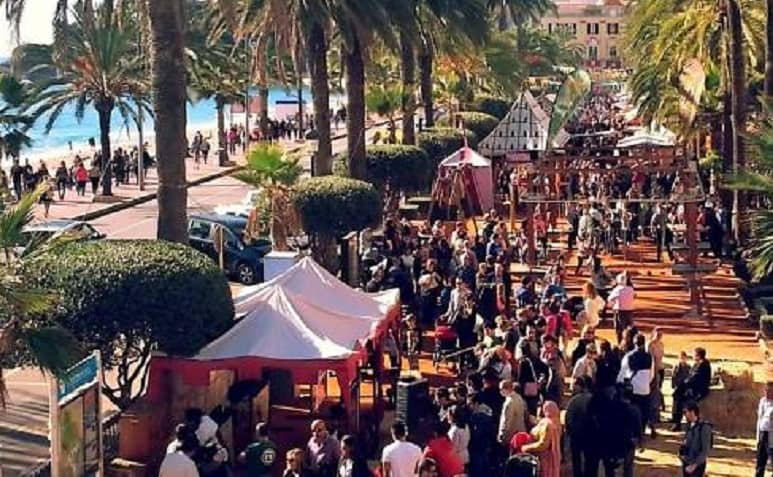
If you want to know more about Lloret de Mar and its (special) markets, please read further at: Market in Lloret de Mar: Where, When and More
3. Museums & historical buildings
You will of course always find another beautiful piece of history in the Museums of a city. This is also the case in Lloret de Mar. Lloret de Mar has plenty of them beautiful historic buildings, part of which today also serves as a museum, and are definitely worth a visit or visit! (also fun to do like it rains in Lloret)
3.1 Can Font
Can Font is a beautiful historic building built in the Catalan modernist style and which is also known as "Cal Conde" or "Can Piuet". It was built in 1877 by master builder and Lloret resident Fèlix Torras y Mataró, at the request of Nicolau Font i Maig. The house symbolizes the Lloretense fortunes brought in by the United States “Indiados”. Since its construction, Can Font has had several owners, until it was bought in 1981 by the city council of Lloret de Mar.
Today Can Font serves as a museum where the beautiful sgraffiti, frescoes and plasters on the walls and ceilings, the ceramic mosaics, the artistic wrought iron railings and grilles, woodwork, stained glass and much more.
Entrance fee:
The entrance fee is € 5 for adults. For pensioners, minors, large families and disabled people, a reduced price of € 2.50 applies.
3.2 Maritime Museum - Can Garriga
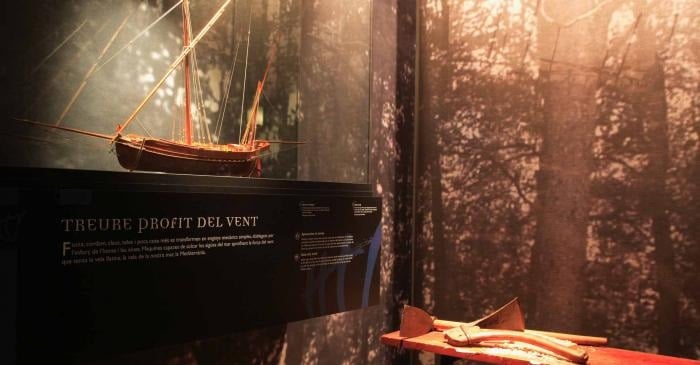
Can Garriga, located on the promenade of Lloret de Mar, is one of the most important 'Indiano' houses in Lloret de Mar.. Twenty-two years after leaving for America, Enric Garriga managed to return to Lloret de Mar in 1887 with a significant fortune. On his return, he decided to have this beautiful house built for his wife and seven children. The house remained family owned until 1981, until it was acquired by the city government.
Today, this prominent home, along with the adjoining property, is home to the Maritime Museum. Here you can learn all about the history and connection that Lloret de Mar has with the sea. During your journey through the different rooms in the museum you will gradually discover the history of the city. You will pass the time that the ships were built on the beach, but also that the ships sailed for the tobacco, coffee and cotton trade to America. On the ground floor are the original ceilings, walls, furniture and floors from the 19th century well kept.
Entrance fees:
The entrance fee is € 4 for adults. For pensioners, minors, large families and disabled people, a reduced price of € 2 applies.
3.3 Can Saragossa
Can Saragossa is a hillside farm surrounded by forests and gardens. Especially in the spring, when the landscape is in bloom, this beautiful farm is a picture to see. This farm, as the name suggests, was built by the Zaragoza family during the rural era of Lloret de Mar.. The first data dates back to 1317. Over time, and with increasing economic resources, the family has completely adapted the farm to its needs, while still maintaining its authenticity.
After Can Saragossa served as a hotel for 10 years in the 1950s, it was in 1984, due to its beautiful history, cost by the city council of Lloret de Mar and turned into a museum.
Entrance fees:
The entrance fee is € 3 for adults. For pensioners, minors, large families and disabled people, a reduced price of € 1.50 applies.
3.4. Ayuntamiento (the town hall of Lloret de Mar)
You can admire the Ayuntamiento, also called Casa de la Villa, on the Passeig Mossèn Jacint Verdaguer, next to the boulevard. Casa de la Villa was built in 1872 by the architects Marí Sureda and Félix de Azúa in one neoclassical style, during the 'Indiano' period. The building is also located to the former shipyard of Lloret de Mar, where ships were built to transport the inhabitants to America.
3.5. Museo del arte “Casa de Gatos”
Located on the central boulevard, not far from the town hall, you will find it opened in 2002 Cat Museum. In the small private museum you will find a colorful collection of everything that has to do with cats. The museum's collection is constantly updated with new interesting exhibitions, beautiful paintings and postcards, soft toys, numerous figurines, home decorations and jewelry. Also this is a wonderful place for the children to visit
3.6. Extravagant villas
As indicated in the 18th many inhabitants of Lloret de Mar are going to try their luck in America. A number of them returned to Spain with a large fortune. Those so-called "Indianos" or "Americanos" left on return extravagant villas build the shoreline to showcase their newly acquired wealth. The luxury villas were built in the typical Modernista style and are now known in Lloret de Mar as “Indianos houses”. So if you are taking a beautiful walk on the boulevard of Lloret de Mar, see if you can find these typical houses! You can recognize the buildings by the windows with stained glass and the ornate pillars.
4. Churches and Monasteries
4.1. Sant Pere del Bosc
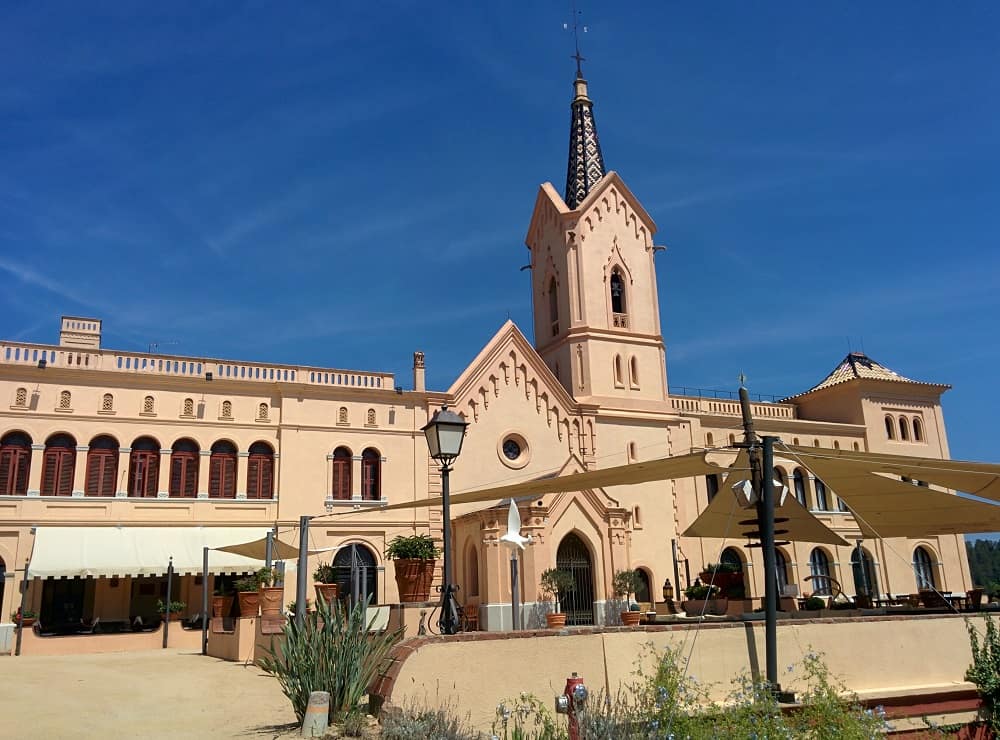
About 5 km from the center of Lloret de Mar, surrounded by nature, you will find the SPA hotel, which was restored in 2011 and rSant Pere del Bosc restaurant. However, this beautiful building is originally a Benedictine monastery, built in the 10th century and inhabited by Benedictine monks called “Sant Pere Salou". During the War of Succession in the late 17the century, however, the monastery was completely destroyed by the French and the monks left for Gerona.
Renovation work started in 1789. The building changed its style for the first time: from Gothic to Baroque. Only in the 19the century, it was given the appearance we see today by architect Puig i Cadafalch. In 1860 the chapel and the land around the monastery were bought by “Americano”, Nicolas Font i Maig. In 1904 a column was built next to the chapel on which an angel, the dengel de Lloret (the Angel of Lloret). This beautiful monastery is definitely worth a visit, and you can also combine this with a delicious dinner in the restaurant of Sant Pere del Bosc
4.2. Iglesia de Sant Roma
The church of Sant Romà is really in the center of Lloret de Mar, so you can hardly miss the church when you visit Lloret de Mar. The church has one beautiful, typical Catalan Gothic style. The striking exterior, with colorful mosaics on the roofs and turrets in a modernist style, is a real eye-catcher.
This impressive catalan gothic church, was built between 1509 and 1522. Over the years, the church has different stylesgot from Byzantine, Islamic, Renaissance until Modernist influences. For example, in 1916 one Modernist style added, which is reflected in the two side chapels, the Baptistry and the Blessed Sacrament. The Sant Romá is truly one of the most spectacular churches in the region! The impressive domes with fascinating color palette will amaze you!
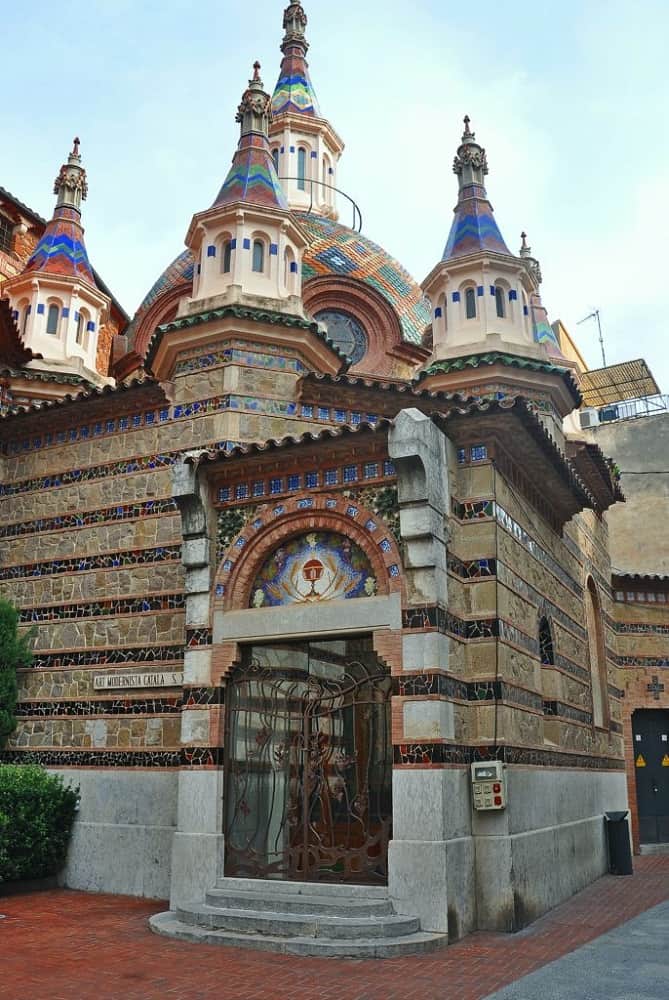
Opening hours:
Open daily from 9:30 am to 12:00 pm and from 4:00 pm to 7:30 pm
Entrance fees:
Free
4.3. Ermita de Les Alegries
The land on which this chapel was built was donated by Lady Sicardis of Lloret de Mar, along with a surrounding area that could be used as a burial site. The beautiful Roman bell tower, the frescoes of Calandria and the ancient oak trees make a visit to this small church worthwhile.
Keep in mind, however, that the small chapel is very limited inside for visitors, only on special chapel festivities. The exterior and surroundings are more than worth a visit!
4.4. Ermita Santa Cristina
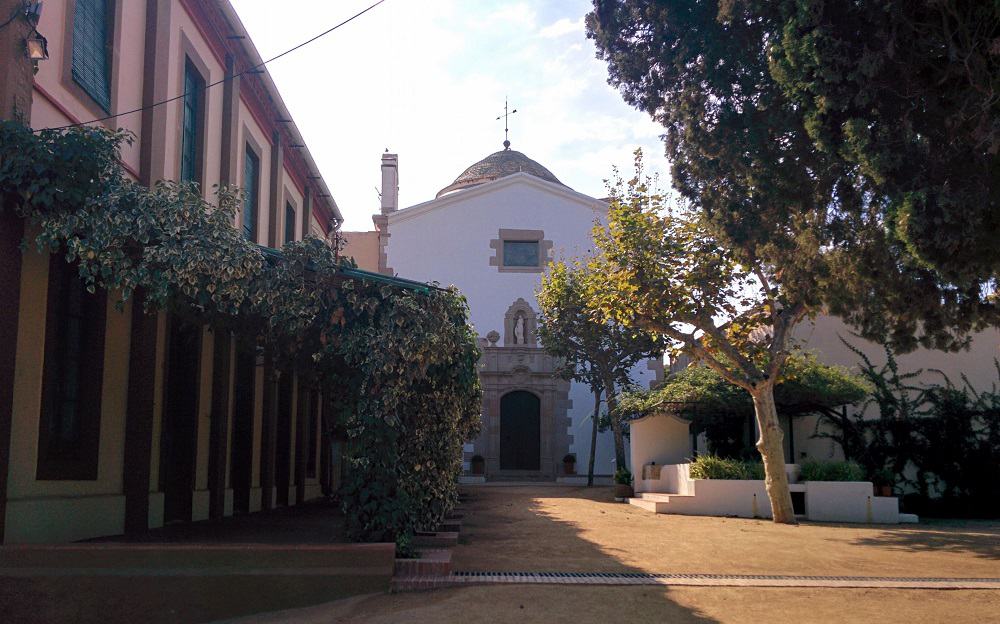
South of Lloret de Mar, about 3.5 km from the center, you will find this beautiful church, the Ermita de Santa Cristina. Santa Chistina is also the patron saint of Lloret de Mar. This neoclassical church was built and used as a hermitage at the end of the 13th century. In the 19th century, the Ermita de Santa Cristina was completely renovated into the church as it is today. It is the masterpiece of this church extraordinary marble altarwhich is made in Italy. In addition, you will also find an interesting one here collection of miniature ships find.
The Santa Cristina Hermitage is located in a magnificent, natural setting with a beautiful sea view. The Ermita de Santa Cristina takes place here every year in July. A procession tour that leads the fishermen from the village to the church. A visit to the Santa Cristina church can also be combined with one day at the beach of Santa Cristina. This beautiful fine sandy beach, with shallow water and a heavenly setting, is considered by many to be the most beautiful beach in Lloret de Mar!
Opening hours:
Open in July and August from 5pm to 7pm
Entrance fee:
Free
4.5. Sants Metges
This small chapel belonged to the former charity hospital of Lloret de Mar, founded in 1445 by Narcís Oliveres. During the construction of a new hospital, this outbuilding was put up for sale by the city council and bought on June 21, 1881 by the canon Dr. Narcís Domènech Parés, who then donated it to the parish. This lovely and historic chapel will pleasantly surprise you!
4.6. Modernist cemetery
Are you up for some diversity? It may not be the first place to visit, but it is one of the impressive sights of Lloret de Mar! The modernist cemetery of Lloret de Mar. The cemetery, built at the turning point of the 20th century, is also called the “Indianos cemetery” called. Today they rest in rich mausoleums in a modernist or Baroque style. These true works of art are a good example of this modernist Catalan funerary art.
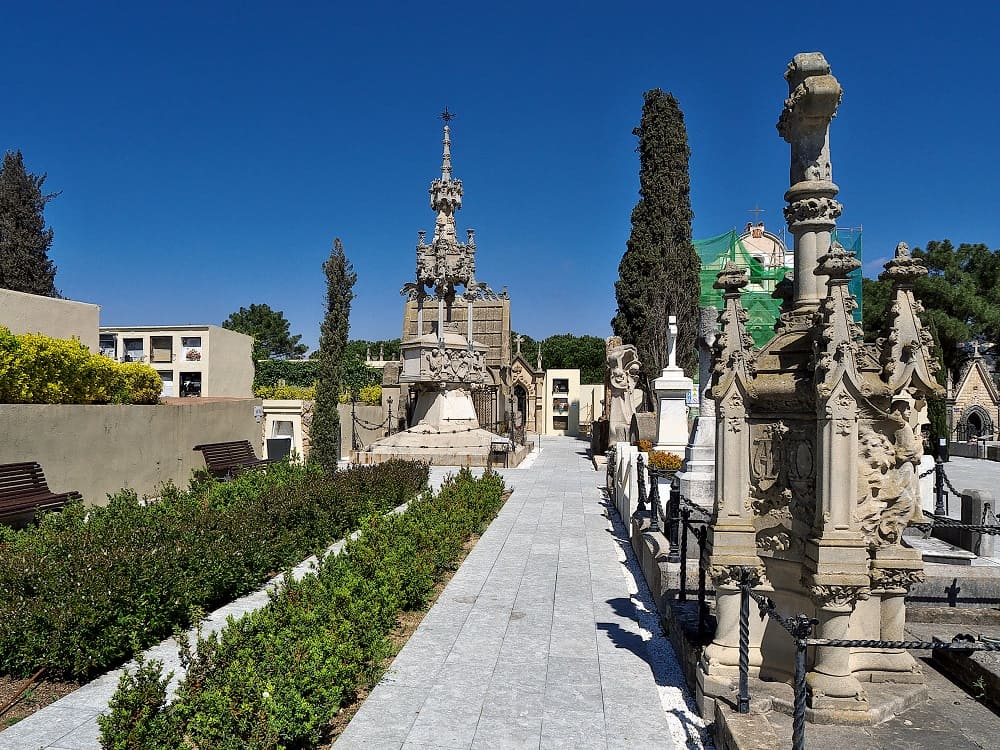
The cemetery in use and gives you the opportunity to be surprised by the beautiful sculptures. Sculptures made by famous architectures such as Josep Puig i Cadafalch, Antoni Gallissà i Soque, Vincente Artigas i Albertí or Bonaventura Conill i Mobtobbio. The tombs that the Indianos had built were also extravagant in every way. The crosses are richly decorated with flowers and there are different statues of angels around the graves.
5. The Botanical Santa Clotilde Gardens
The Santa Clotilde Gardens enjoy a spectacular cliff-top location with stunning views over the sea and the Costa Brava. This beautifulth gardens next to Fenals beach and are almost 100 years old. This romantic botanical garden is considered one of the best historical Mediterranean gardens in Europe. In addition to the breathtaking view, you can enjoy this fountains, marble sculptures and exotic trees and flowers. The gardens are also easy to combine with a visit to Fenals beach.
Perhaps also interesting to know that you can get from Lloret de Mar with a Garden Tour Bus to several gardens in the area. This way, in addition to the Santa Clotilde gardens, you can also easily visit the botanical garden Pinya de Rosa or the great pride of Blanes, Mar i Murtra.
Santa Clotilde Gardens opening hours:
High season (April-October) - open daily from 10am to 8pm.
Winter season (November - January) - open daily from 10am to 5pm
Pre-season (February-March) - open daily from 10am to 6pm
Pay attention: closed on December 25 and 26 and January 1 and 6
Entrance fees:
The entrance fee to Santa Clotilde is € 5 for adults. For pensioners, minors, large families and disabled people, a reduced price of € 2.50 applies.
6. Discover the 3 Iberian Archaeological Settlements
6.1 Puig de Castellet Iberian ruins
Puig de Castellet is an old and small settlement, with about 6 houses, of the first inhabitants of Lloret de Mar. The ruins are such 2300 years old and are located 2 kilometers from the center of Lloret de Mar. Puig de Castellet played an important role during the Punic Wars. The ancient ruins were excavated in 1943 and are of great historical value. Puig de Castellet, presumably an outpost of a larger center (possibly the settlement of Montbarbat further inland), is located on the northwestern side on a hill 200 meters above sea level. You can enjoy a panoramic view of Lloret and Blanes here.
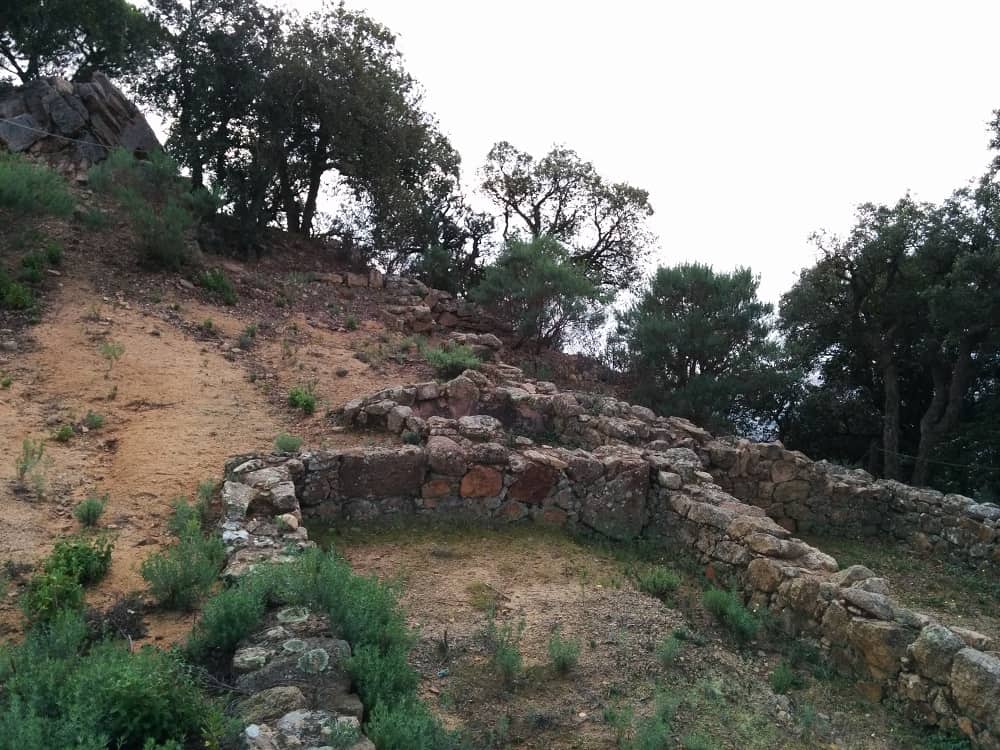
Entrance fees:
The entrance fee is € 3 for adults. For pensioners, minors, large families and disabled people, a reduced price of € 1.50 applies.
6.2. Turó Rodó
The settlement of Turó Rodó is the closest to the city center of Lloret de Mar. Dating back to the 3rd century BC, this small village was presumably a precursor to a larger Iberian settlement further inland: Montbarbat. This small Iberian settlement is located on a small peninsula, at an altitude of 40 meters, just behind the iconic Castell d'en Platja. Archaeological remains found here suggest that the settlement served both as a lookout point and as a commercial center for trade with other villages around the Mediterranean.
Turó Rodó is an absolute must-see for those who would like to know how the first inhabitants of Lloret de Mar lived, as you will find here a replica of an Iberian house built with authentic methods and materials that reflect the time period. Finally, you can also enjoy a beautiful view over the bay of Lloret de Mar.
Entrance fees:
The entrance fee for Turó Rodó is € 3 for adults. For pensioners, minors, large families and disabled people, a reduced price of € 1.50 applies.
6.3. Montbarbat
This is, of the three, the largest Iberian settlement (5,700 m2), about 7 kilometers from the center of Lloret de Mar. Montbarbat, because it is surrounded by defensive walls and towers, the most important settlement in the region. Some streets, as well as houses and other buildings (such as shops) from the 3rd and 4th centuries BC have been excavated. Some fragments of imported Attic pottery have also been found here, testifying to the presence and influence of the Greek world in Lloret de Mar.
Note: This settlement is currently being excavated and therefore cannot be visited!
7. Dona Marinera
Find out historical heritage of Lloret de Mar "Dona Marinera". Since Dona Marinera was created (in 1966), it has become one of the most iconic symbols of Lloret de Mar. From the main beach of Lloret de Mar you walk along the coastal path, clockwise along the boulevard, to Dona Marinera, the fisherwoman of Lloret de Mar. The female shaped bronze statue stands perky on a rock, from where the fisher woman watches over the sea.
Because of its artistic beauty and exceptional quality, the statue is often called the Venus of Lloret de Mar. However, behind this phenomenal image is, as it should be, also a legend. That if you touch the feet of the Fisherwoman and simultaneously look at the horizon, your wish will come true. So it is definitely worth a try during your visit in Lloret de Mar!
8. Caminos de Ronda
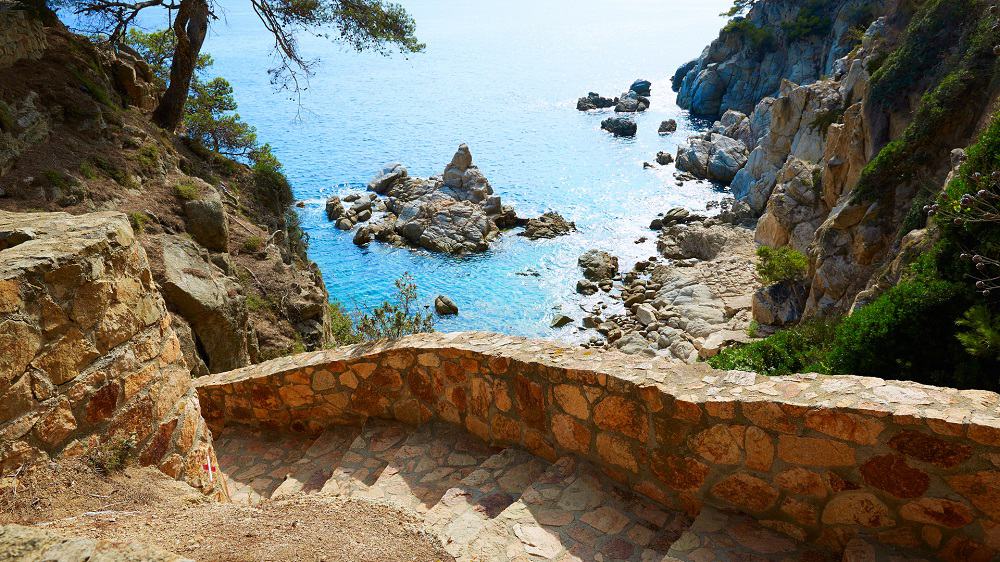
The Caminos de Ronda is a walking route along the entire Costa Brava of no less than 583 km. Also known as GR-92, the route runs from the French border to the Ebro Delta. Of course it is impossible to walk the entire route during your stay in Lloret de Mar, but from Lloret de Mar you can two beautiful routes definitely try it.
The first walking route runs from La Caleta, from where you have a beautiful view over the sea to Cala Trons. You can even go from here walk through to the beautiful Tossa de Mar.. The second part of the Caminos de Ronda departs from the south side of Lloret de Mar beach to the rocky Cala Banys, and runs all the way to the lovely seaside town of Blanes. Here, too, you can enjoy breathtaking views during your hike.
Enjoy a real Spanish night out!
Of course it is also going out and the whole associated entertainment scene Lloret de Mar an attraction in itself; with hundreds of thousands of lights at night, thousands of their best dressed partygoers and hundreds of entertainment centers. Even if you don't like going out, it can be a great experience to go on a terrace, while enjoying a snack and drink, be amazed at everything that happens around you.
Another real attraction in terms of going out is of course attending a real flamenco show, with vocals, guitar playing, dance & authentic costumes. During such an evening you not only experience, but also really feel, the authentic Spanish culture. Flamenco evenings are regularly organized in the Gran Casino Costa Brava in Lloret de Mar. You can find more information about tickets, dates and prices here.
Take an unforgettable City trip to Barcelona
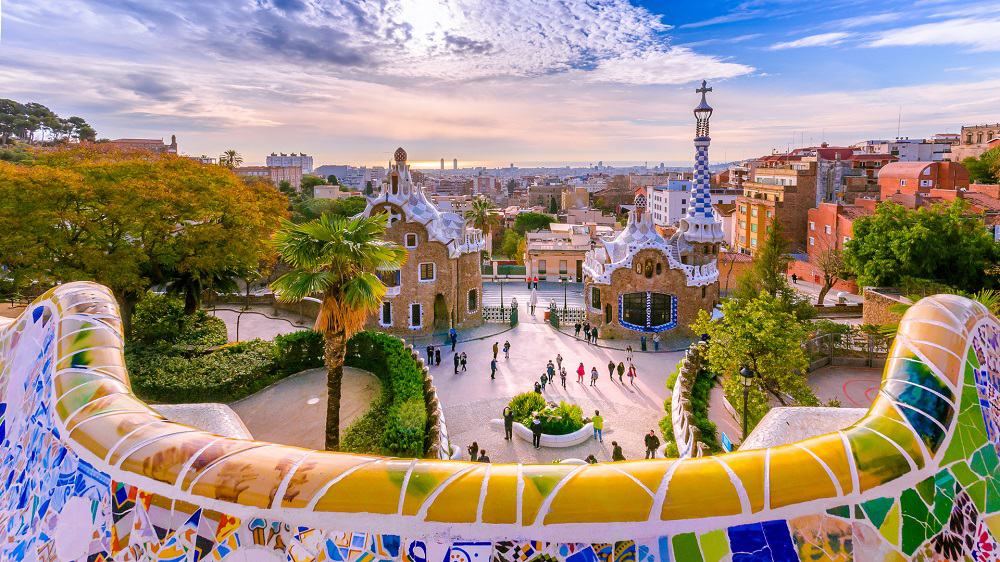
Although this is of course not an attraction of Lloret de Mar, this cosmopolitan city should not be missing from this list! You will find it just an hour's drive from Lloret de Mar. the metropolis of Barcelona al. So you can Barcelona on your own easy to do by car, bus or train, but you can also join one of the many excursions that depart daily from Lloret de Mar to Barcelona.
Combine your holiday in Lloret de Mar with a visit to Barcelona! Stroll along the Ramblas, admire the world famous Sagrada Familia, walk through Gaudi's Parc Güell, visit the Camp Nou stadium and discover so much more that this city has to offer!
Do you want to know more about Barcelona or about the field trips you can do from Lloret de Mar ?! Then take a look at:
Day trip from Lloret de Mar to Barcelona: Top 10 sights!
Do you want during your vacation not just seeing things , but also to do things? Then look here for the Activities in Lloret de Mar!
Curious about the best sights in Tossa de Mar, look here!

